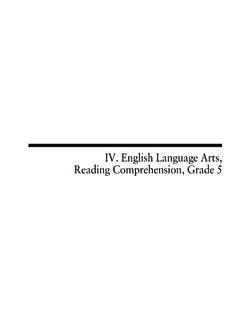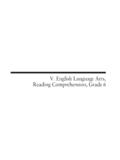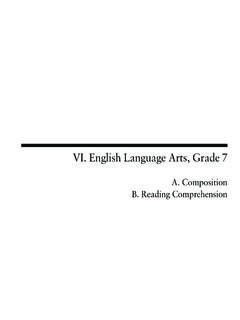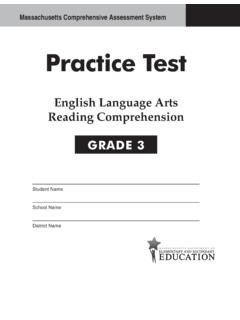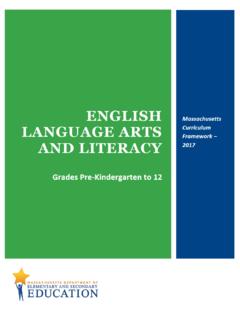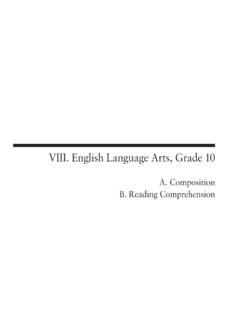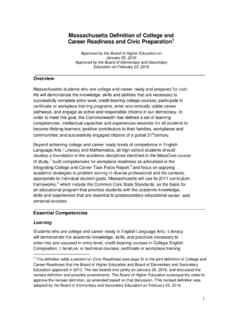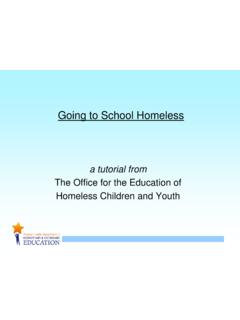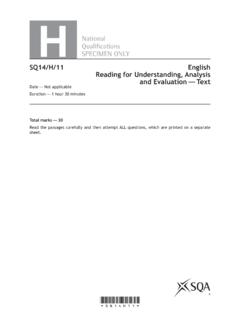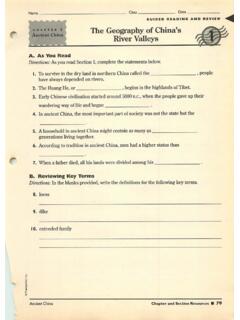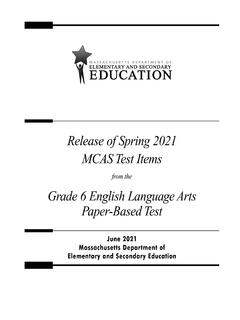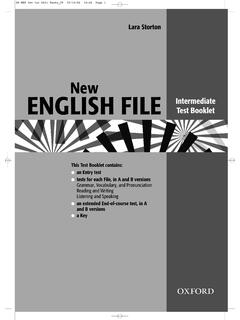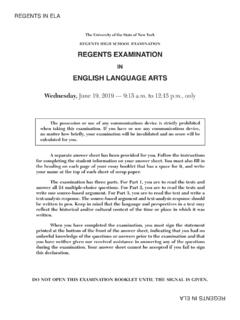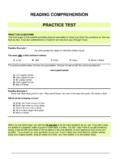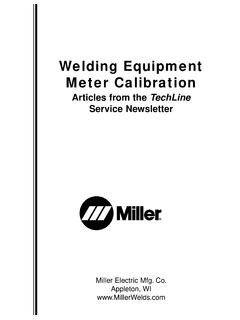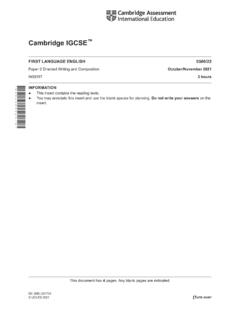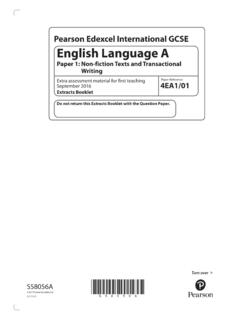Transcription of VI. English Language Arts, Grade 7
1 VI. English Language Arts, Grade 785 Grade 7 English Language Arts TestThe spring 2019 Grade 7 English Language Arts test was a next-generation assessment that was administered in two primary formats: a computer-based version and a paper-based version. The vast majority of students took the computer-based test. The paper-based test was offered as an accommodation for students with disabilities who are unable to use a computer, as well as for English learners who are new to the country and are unfamiliar with of the operational items on the Grade 7 ELA test were the same, regardless of whether a student took the computer-based version or the paper-based version. In places where a technology-enhanced item was used on the computer-based test, an adapted version of the item was created for use on the paper test. These adapted paper items were multiple-choice or multiple-select items that tested the same ELA content and assessed the same standard as the technology-enhanced document displays released items from the paper-based test.
2 Released items from the computer-based test are available on the MCAS Resource Center website at Test Sessions and Content Overview The Grade 7 ELA test was made up of two separate test sessions. Each session included reading passages, followed by selected-response questions and essay questions. On the paper-based test, the selected-response questions were multiple-choice items and multiple-select items, in which students select the correct answer(s) from among several answer and Reporting CategoriesThe Grade 7 ELA test was based on grades 6 12 learning standards in three content strands of the Massachusetts Curriculum Framework for English Language Arts and Literacy (2017), listed below. Reading Writing Language The Massachusetts Curriculum Framework for English Language Arts and Literacy is available on the Department website at ELA test results are reported under three MCAS reporting categories, which are identical to the three framework content strands listed above.
3 The tables at the conclusion of this chapter provide the following information about each released and unreleased operational item: reporting category, standard(s) covered, item type, and item description. The correct answers for released selected-response questions are also displayed in the released item table. Reference MaterialsDuring both ELA test sessions, the use of bilingual word-to-word dictionaries was allowed for current and former English learner students only. No other reference materials were allowed during any ELA test 7 English Language ArtsThis session contains 16 each passage and question carefully. Then answer each question as well as you can. You must record all answers in this Test & Answer most questions, you will mark your answers by filling in the circles in your Test & Answer booklet . Make sure you darken the circles completely. Do not make any marks outside of the circles.
4 If you need to change an answer, be sure to erase your first answer questions will ask you to write a response. Write your response in the space provided. Only responses written within the provided space will be Language Arts 8786EL628648168 passageRead the excerpt from With a Little Luck about the English scientist Isaac Newton, who lived from 1642 to 1727. Then answer the questions that With a Little Luckby Dennis Brindell Fradin1 As a child, Isaac attended two different schools near Woolsthorpe where he learned reading, writing, and arithmetic. For quite a while he wasn t much of a student. Instead of studying his schoolwork, he preferred to play by himself, draw, and build and invent He built sundials devices that keep time by measuring the changing angle of the sun s shadow including two sundials he carved on the side of his house at Woolsthorpe.
5 He put together a model windmill. On windless days, Isaac powered his miniature mill with a pet mouse he called the miller, who set the device in motion by chasing bits of corn. Isaac also loved to build kites. In those days, many people were terrified of comets, which were believed to be omens of coming disasters. Isaac attached lanterns to the tails of sturdy kites and flew them at night. He thought it was a great joke when his neighbors spotted one of his illuminated kites in the sky and spread the alarm about the new comet. Another of his childhood inventions was a four-wheeled carriage that the driver operated by turning a handle from inside the little vehicle. It may have been the first toy car ever At the age of twelve, Isaac was sent off to King s School at Grantham, about six miles from Woolsthorpe.
6 Because of the school s distance from home, his mother arranged for Isaac to board with an apothecary (what we would call a pharmacist) named Mr. Clark. Isaac enjoyed living at the Clarks . He must have had quite a time helping Mr. Clark mix medicines, for in those days it was believed that the more foul-tasting the concoction, the better its chances to drive off disease. For his living space, Isaac was given the Clarks attic. He covered its walls with mathematical diagrams as well as with pictures he drew and framed of famous people, birds and other animals, and sailing vessels. But it took a kick in the stomach for Isaac to start applying himself at King s The students at the school were ranked according to their academic achievements. Isaac quickly sank to the bottom, ranking next to last in a class of nearly a hundred students.
7 One day as the students headed to school, the boy who ranked just ahead of him gave him an unexpected and painful kick. Infuriated, Isaac challenged the boy to meet him in English Language Arts 88the churchyard at the end of the day. The two fought, and Isaac won, but afterward someone reminded Isaac that the vanquished boy still stood above him in school. Isaac began concentrating on his studies so intensely that he gradually rose to the top position in his Meanwhile, Isaac s stepfather, Barnabas Smith, had died and his mother had returned to Woolsthorpe. Accompanying her were two sons and a daughter that she had had with Smith. When Isaac was about fifteen, his mother informed him that his school days were over. The time had come for him to return home and help run the Isaac, who had grown to love school, was furious.
8 He returned home as ordered but refused to do farm chores. Instead of working in the fields, he sat under a tree reading a book, or building wooden models with his tools. Instead of tending the sheep, he allowed them to wander onto a neighbor s property, causing damage that his mother had to pay for. When his mother sent Isaac to Grantham on Saturday mornings to sell the family s crops and buy supplies, he neglected his tasks and went to his old room in the Clarks attic to read. Finally Henry Stokes, the King s School headmaster (what we would call the principal), decided to speak out for the youth who had risen from the bottom to the top of his class. Mr. Stokes visited Isaac s mother and informed her that her son had a brilliant scientific mind. He convinced her that Isaac should complete his studies at King s School and then go on to the Around the time that Isaac returned to school he performed one of his first scientific experiments.
9 On a calm day, Isaac jumped as far as he could and measured the distance. Then, during a powerful storm, he jumped first with the wind at his back, then against the wind. He could jump considerably farther with the wind s help, he found. He then invented a formula to measure the force of a storm based on how far he could jump with and against the After finishing up at King s School, eighteen-year-old Isaac entered Cambridge University in 1661. He enrolled as a sizar a student who paid his way through college by waiting tables, running errands, and doing odd jobs. He didn t do very well in college, probably because he spent so much time studying mathematics and astronomy. He read Nicolaus Copernicus s work and became convinced that Earth orbited the sun, as the Polish astronomer had claimed.
10 He also read the writings of Johannes Kepler, who declared that some mysterious rays bound the planets in their orbits, and of Galileo, who had observed the heavens with his Language Arts 89889 Isaac didn t have a telescope yet, but he began making naked-eye observations of the sky. He observed a comet in late 1664, and another in the spring of 1665. He gazed at the moon and the planets by night, and hurt his eyes looking at the sun in a mirror by day. Isaac wondered: What kept the moon orbiting Earth, and Earth and the other planets orbiting the sun?10 In the spring of 1665, at the age of twenty-two, Isaac Newton received his bachelor s degree from Cambridge University. He graduated without special distinction. He was planning to continue at Cambridge in pursuit of his master s degree when England suffered a severe outbreak of bubonic plague a disease caused by bacteria transferred from rats to people by fleas.

